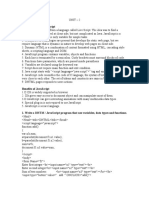0 ratings0% found this document useful (0 votes)
57 viewsJavascript An Object Based Language
The document discusses JavaScript objects and various native JavaScript objects like Date, String, Array and Math. It explains how to create and use objects, their properties and methods. Specific methods of different objects are described along with examples.
Uploaded by
Banda E WaliCopyright
© © All Rights Reserved
Available Formats
Download as PPT, PDF, TXT or read online on Scribd
0 ratings0% found this document useful (0 votes)
57 viewsJavascript An Object Based Language
The document discusses JavaScript objects and various native JavaScript objects like Date, String, Array and Math. It explains how to create and use objects, their properties and methods. Specific methods of different objects are described along with examples.
Uploaded by
Banda E WaliCopyright
© © All Rights Reserved
Available Formats
Download as PPT, PDF, TXT or read online on Scribd
You are on page 1/ 17
Lecture
JavaScript An Object Based
Language
What are Objects?
What is Object in real world?
Cars, Computers, Tables etc
How to define a Car?
Blue Car, 150 km/h speed, Manual
These are properties of the car e-g colour = blue
How to use a Car?
Turn ignition key, press the pedal, beep the horn etc
These are the methods of the car object
Some time methods use information, sometime
provide information
Some time methods change the properties value
Car is defined by collection of methods and properties
Why JavaScript Objects
Primitive data
Not too Complex and easy to deal with
But all information is not simple e-g time calculation
Is there any easier way to deal with complex
information like times and dates?
Objects can be used in this situation
Use Date objects which have variety of properties
and methods
getTime(), getHour(), getMinutes() etc
Number of objects are available in JavaScript
Using JavaScript Objects
Creating an Object
var myVariable = new ConstructorName(opt parameters);
Examples
var myDate = new Date();
var myDate = new Date(1 Jan 2010);
How data stores
With primitives, variable stores the actual values
With object, variable stores references to the memory
address where data is actually stored.
Using JavaScript Objects
Using an Objects Property
ObjectVariable.PropertyName
Example: myArray.length;
Some properties are read-only
Calling an Objects Method
ObjectVariable.MethodName(Opt Parameters)
Some methods return a value
Some methods do a task
Example:
myData.getMinutes(); (Return minutes)
myArray.sort() (Sort the array)
Primitives vs Objects
There are String, Number and Boolean objects
corresponding to String, Number and Boolean data
types
Example:
var myString = new String(Im a String object);
var lengthOfString = myString.length;
But if we have
var mySecondString = Im a primitive string;
How to find the length of this string?
JavaScript temporarily convert this primitive string to
string Object just for the operation
JavaScript Native Objects
String Object Methods
Searching String within another string:
indexOf() , lastIndexOf()
Take two parameters (String to search, Starting Position)
Copying part of a String
subStr() and subString()
Takes two parameters (start Postion, Last Position/
Number of characters)
Last parameter is optional
JavaScript Native Objects
Converting Cases of characters:
toLowerCase() , toUpperCase()
Return a string in desired case
Selecting a single character from a string
charAt() and charCodeAt()
Takes two parameters (start Postion, Last Position/
Number of characters)
Last parameter is optional
Converting character codes to a string
fromCharCode()
Takes coma separated numbers as character codes
Return a string on the basis of code passed
Array Object
Finding out how many elements in an array
length property
myArray.length
Joining Arrays
concat() method return the union of two arrays
thirdArray = firstArray.concat(secondArray);
firstArray = firstArray.concat(secondArray);
Copying part of an Array
slice() method return an array depending on parameters
Take two parameters startIndex, lastIndex(optional)
Array Object
Converting an Array to a single string
join() method return a string of the elements of the array
thirdString = myArray.join(@);
Parameter is optional, if not given comma will be inserted
Putting an Array in order / reverse order
sort() make the order of elements decending/acending
(alphabatically/ numerically)
reverse() put the array elements in reverse order
The Math Object
Provide a number of useful mathematical number
manipulation methods
No need to define a variable as math object, JavaScript
automatically create them
Accessing math object properties and call methods
math.propertyName ---->> math.PI
Math.MethodName() ---->> math.abs(parametr)
abs(number) return the absolute value of number
The Math Object
Finding the largest and smallest number
Math.max(n1, n2) return largest number among n1 and n2
Math.min(n1, n2) return smallest number among n1 and n2
Math.random() method
Return a random floating-point number between 0 and 1
0 is included and 1 is not included
Math.pow(n, p)
Take two parameters the number and specified power to raise
the number
Return a number equal to n^p
The Math Object
Rounding numbers
Math.ceil(n) round the n up to the next whole number
Math.floor(n) remove decimal point and return whole number
Math.round(n) round up or round down depending on number
Summary of rounding methods
The Date Object
Can be used to
Find the current date and time
Store your own dates and time
Do calculations with these dates
Converts the dates into strings
Creating Date object
var myDate = new Date() {current date and time}
Date() can take number milliseconds since 1 Jan 1970 at
00:00:00 GMT
Var myDate = new Date(1395278000000);
Set the date Mar 20 2014 06:13:20 GMT
The Date Object
Getting Date values
Following methods can be used with any date object to get
values of different properties of your date object
The Date Object
Setting Date values
Following methods can be used with any date object to set
the values within your date object
Examples
myDateObject.setFullYear(2009);
myDateObject.setDate(27);
myDateObject.setMonth(1);
The Date Object
Getting Time values
getHours()
getMinutes()
getSeconds()
getMilliSeconds()
Setting the Time values
setHours()
setMinutes()
setSeconds()
setMilliSeconds();
You might also like
- C in Depth (2nd Ed.) (Srivastava 2009-06-30) PDF75% (16)C in Depth (2nd Ed.) (Srivastava 2009-06-30) PDF550 pages
- Web Design and Development Lecture 9 B - JavaScript AdvancedNo ratings yetWeb Design and Development Lecture 9 B - JavaScript Advanced34 pages
- Date Object: Javascript Quick Reference CardNo ratings yetDate Object: Javascript Quick Reference Card2 pages
- MSDN May 2007: Create Advanced Web Applications With Object-Oriented Techniques100% (2)MSDN May 2007: Create Advanced Web Applications With Object-Oriented Techniques22 pages
- Chapter 3: Client-Side Scripting LanguageNo ratings yetChapter 3: Client-Side Scripting Language21 pages
- BE 5 IT GECBVN BharatVainsh Unit 5(JavaScript) WD 3151606 2023No ratings yetBE 5 IT GECBVN BharatVainsh Unit 5(JavaScript) WD 3151606 202398 pages
- Advanced Javascript: Arrow Functions, Template Literals, Array DestructingNo ratings yetAdvanced Javascript: Arrow Functions, Template Literals, Array Destructing9 pages
- Complete A Z Javascript Notes 1682741974No ratings yetComplete A Z Javascript Notes 168274197485 pages
- Digital Image Processing (DIP) : Dr. Muhammad Nawaz Assistant Professor (Multimedia Technologies)No ratings yetDigital Image Processing (DIP) : Dr. Muhammad Nawaz Assistant Professor (Multimedia Technologies)37 pages
- CMP 301 (NEW) Object Oriented Programming Langauage INo ratings yetCMP 301 (NEW) Object Oriented Programming Langauage I79 pages
- B161753 - Shaik Sameer - Oops - Week3 PDFNo ratings yetB161753 - Shaik Sameer - Oops - Week3 PDF7 pages
- 3G - Current - Radio Parameter and ValueNo ratings yet3G - Current - Radio Parameter and Value31 pages
- OOPS in Python (Inheritance, Polymorphism, Exception Handling)No ratings yetOOPS in Python (Inheritance, Polymorphism, Exception Handling)11 pages
- Chapter-5-section-2-Verifying-Trig-Identities-worked-out-solutionsNo ratings yetChapter-5-section-2-Verifying-Trig-Identities-worked-out-solutions6 pages
- 12 Structure, Typedef & Enumerated Data Type: L L L LNo ratings yet12 Structure, Typedef & Enumerated Data Type: L L L L12 pages
- Student Counselling Source Code: ServerNo ratings yetStudent Counselling Source Code: Server13 pages
- 01-Object Oriented Programming (1) - Jupyter NotebookNo ratings yet01-Object Oriented Programming (1) - Jupyter Notebook9 pages
- Predefined Functional Interfaces - Making Java Easy To LearnNo ratings yetPredefined Functional Interfaces - Making Java Easy To Learn6 pages
- Foundations of Java Programming - OOP Option - Călin Galeriu - LULU 2020 PDFNo ratings yetFoundations of Java Programming - OOP Option - Călin Galeriu - LULU 2020 PDF103 pages
- Web Design and Development Lecture 9 B - JavaScript AdvancedWeb Design and Development Lecture 9 B - JavaScript Advanced
- MSDN May 2007: Create Advanced Web Applications With Object-Oriented TechniquesMSDN May 2007: Create Advanced Web Applications With Object-Oriented Techniques
- BE 5 IT GECBVN BharatVainsh Unit 5(JavaScript) WD 3151606 2023BE 5 IT GECBVN BharatVainsh Unit 5(JavaScript) WD 3151606 2023
- Advanced Javascript: Arrow Functions, Template Literals, Array DestructingAdvanced Javascript: Arrow Functions, Template Literals, Array Destructing
- Advanced C Concepts and Programming: First EditionFrom EverandAdvanced C Concepts and Programming: First Edition
- Digital Image Processing (DIP) : Dr. Muhammad Nawaz Assistant Professor (Multimedia Technologies)Digital Image Processing (DIP) : Dr. Muhammad Nawaz Assistant Professor (Multimedia Technologies)
- CMP 301 (NEW) Object Oriented Programming Langauage ICMP 301 (NEW) Object Oriented Programming Langauage I
- OOPS in Python (Inheritance, Polymorphism, Exception Handling)OOPS in Python (Inheritance, Polymorphism, Exception Handling)
- Chapter-5-section-2-Verifying-Trig-Identities-worked-out-solutionsChapter-5-section-2-Verifying-Trig-Identities-worked-out-solutions
- 12 Structure, Typedef & Enumerated Data Type: L L L L12 Structure, Typedef & Enumerated Data Type: L L L L
- 01-Object Oriented Programming (1) - Jupyter Notebook01-Object Oriented Programming (1) - Jupyter Notebook
- Predefined Functional Interfaces - Making Java Easy To LearnPredefined Functional Interfaces - Making Java Easy To Learn
- Foundations of Java Programming - OOP Option - Călin Galeriu - LULU 2020 PDFFoundations of Java Programming - OOP Option - Călin Galeriu - LULU 2020 PDF






























































































